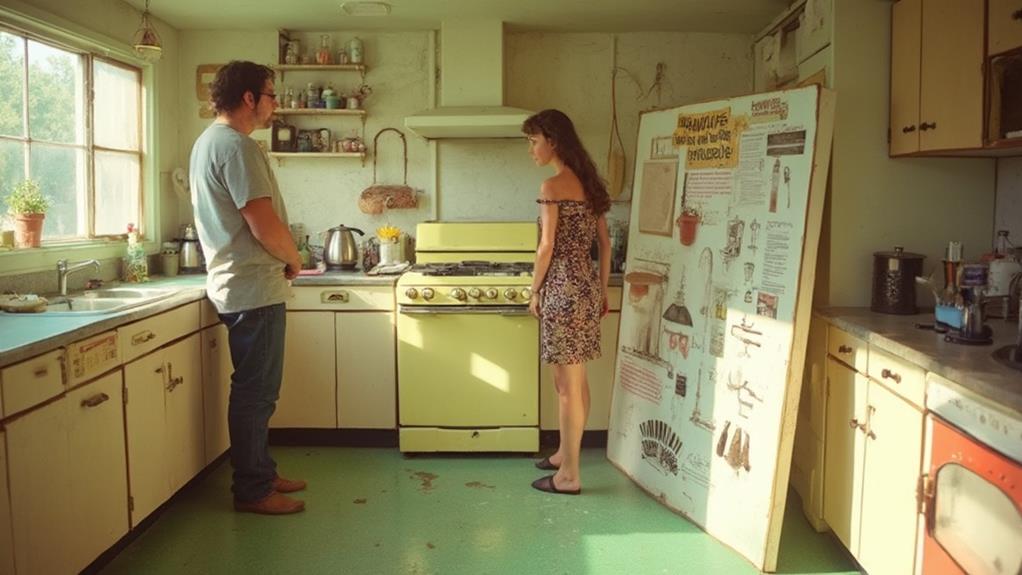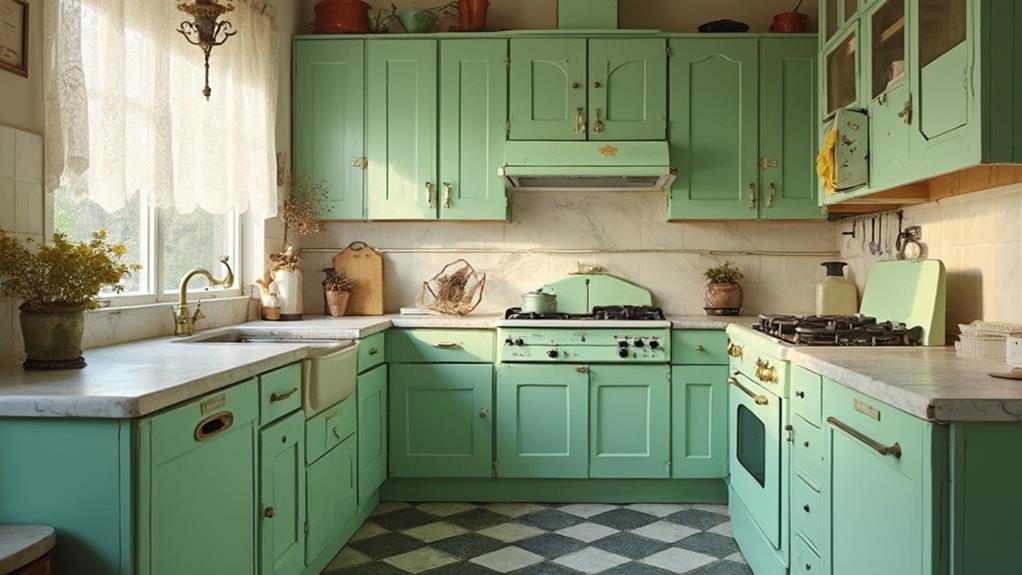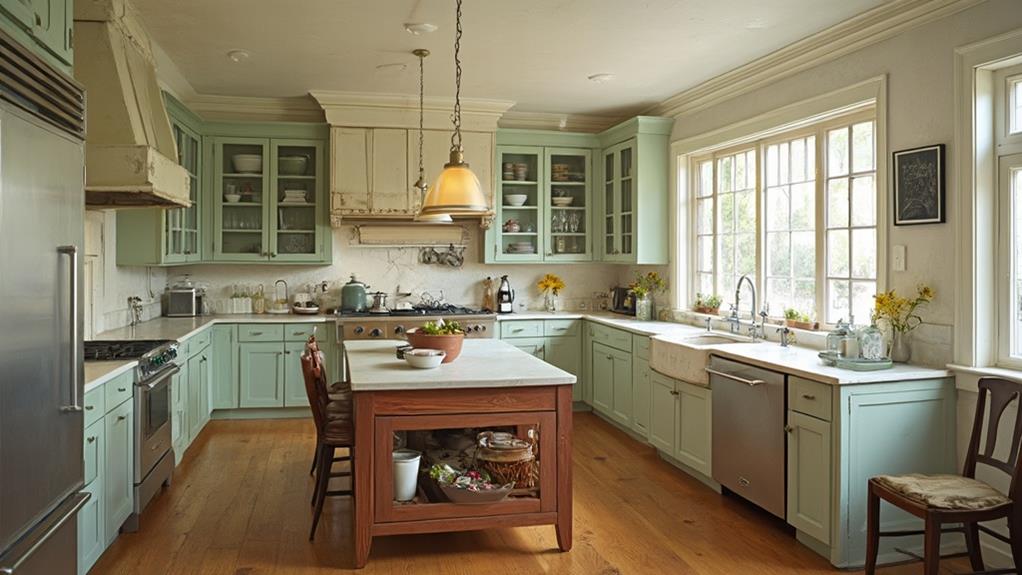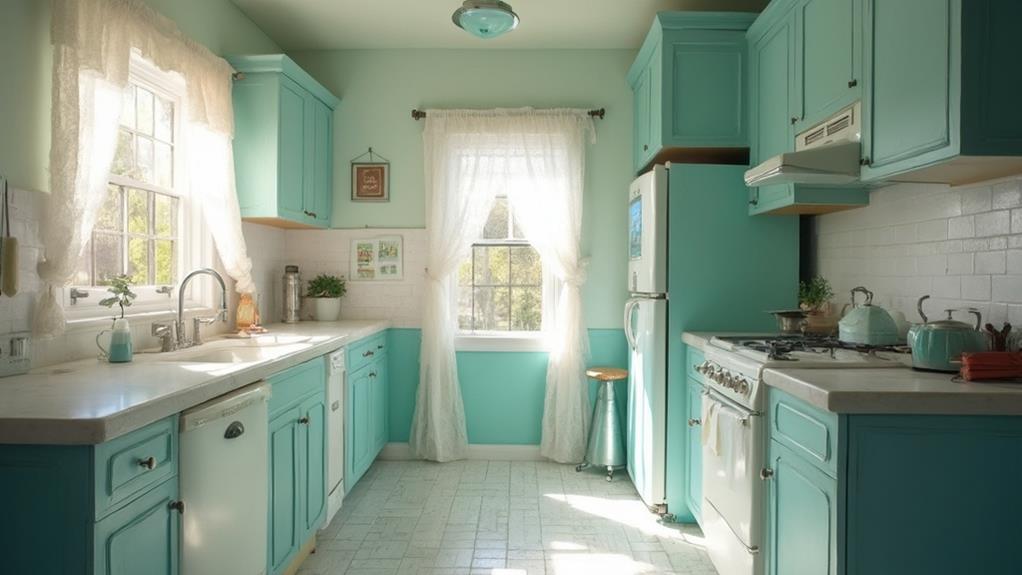To modernize your vintage kitchen while preserving its charm, start by evaluating its current state and identifying elements worth keeping. Upgrade appliances with retro-inspired models that blend old-school aesthetics with modern functionality. Refresh cabinets and countertops by refinishing rather than replacing, and opt for period-appropriate colors and materials. Mix vintage-inspired lighting fixtures with contemporary options for improved illumination. Carefully preserve original architectural details like crown molding or wainscoting, while discreetly incorporating modern amenities. By striking the right balance between updates and preservation, you'll create a kitchen that honors its past while meeting your present-day needs. Discover how to tackle each aspect of your renovation for optimal results.
Assessing Your Vintage Kitchen

Before diving into any renovation project, take a close look at your vintage kitchen. Evaluate its current state, identifying both the charming elements you want to preserve and the areas that need updating. Consider the layout, appliances, cabinetry, countertops, flooring, and lighting.
Assess the functionality of your kitchen. Does it meet your cooking needs? Is there enough storage space? Are the work zones efficient? Take note of any structural issues, such as outdated wiring or plumbing, that may require professional attention.
Examine the architectural features that give your kitchen its vintage character. These might include original moldings, built-in cabinets, or unique hardware. Decide which elements you'll keep and which you'll replace or update.
Document your kitchen's current state with photographs and measurements. This will help you plan your modernization project and serve as a reference point. Research the era of your vintage kitchen to understand its design principles and materials. This knowledge will guide you in making choices that blend modern functionality with period-appropriate aesthetics.
Upgrading Appliances With Retro Flair
When upgrading appliances in your vintage kitchen, you don't have to sacrifice retro style for modern functionality. Many manufacturers now offer appliances that combine classic aesthetics with cutting-edge features.
Look for refrigerators with rounded edges and chrome accents that echo 1950s designs, but boast energy-efficient cooling systems and smart technology. Similarly, you'll find ranges with vintage-inspired knobs and analog clocks that house convection ovens and induction cooktops.
For smaller appliances, consider colorful stand mixers or toasters that mimic mid-century shapes while incorporating modern safety features and precise controls. Dishwashers can be disguised behind retro-style cabinet fronts, maintaining the vintage look while providing quiet, water-saving operation.
Don't forget about vintage-inspired vent hoods that can house powerful, modern ventilation systems. Microwaves can be hidden in drawers or cabinets to preserve the period look. When selecting appliances, prioritize those with durable materials and timeless designs to ensure they'll complement your kitchen for years to come.
Refreshing Cabinets and Countertops

After updating your appliances, it's time to turn your attention to the cabinets and countertops. These elements play a crucial role in defining your kitchen's overall aesthetic and functionality.
For cabinets, consider refinishing rather than replacing to maintain the vintage charm. Sand them down and apply a fresh coat of paint in a period-appropriate color. Alternatively, you can strip them to reveal the original wood grain and apply a clear varnish for protection.
For countertops, opt for materials that blend vintage appeal with modern durability. Butcher block counters offer a timeless look and can be easily maintained. If you prefer a more durable option, consider quartz or granite in colors and patterns that complement your kitchen's era. For a truly authentic feel, salvaged materials like reclaimed wood or vintage tile can be repurposed as countertops.
Don't forget the hardware. Replace old knobs and pulls with reproductions that match your kitchen's era. Brass, chrome, or glass options can add a touch of elegance. Remember to keep the overall design cohesive by choosing finishes that complement your new appliances and color scheme.
Lighting: Blending Old and New
Throughout your kitchen renovation, lighting plays a pivotal role in creating the perfect blend of vintage charm and modern functionality. To achieve this balance, consider combining classic fixtures with contemporary elements. Start by assessing your kitchen's natural light sources and identifying areas that need additional illumination.
For ambient lighting, opt for a vintage-inspired chandelier or pendant light as a focal point. Choose fixtures with antique finishes like brass or copper to maintain a period feel. Complement these with recessed LED lights for even, energy-efficient illumination. Under-cabinet lighting adds a modern touch while improving task visibility.
Don't forget about accent lighting to highlight architectural features or display vintage kitchenware. Use adjustable spotlights or picture lights to draw attention to these elements. For a unique twist, repurpose old mason jars or enamelware as DIY pendant lights.
When selecting bulbs, opt for warm white LEDs that mimic the soft glow of incandescent bulbs. Install dimmer switches to create ambiance and save energy. By thoughtfully combining vintage-inspired fixtures with modern lighting technology, you'll create a well-lit kitchen that honors its history while embracing contemporary convenience.
Preserving Original Architectural Details

Original architectural details often serve as the soul of a vintage kitchen, imbuing the space with character and history. As you modernize your kitchen, it's crucial to identify and preserve these unique elements.
Start by assessing features like crown molding, wainscoting, built-in cabinetry, and original hardware. If they're in good condition, consider restoring rather than replacing them.
For damaged woodwork, consult a professional restoration expert who can repair and refinish it to its former glory. If you must replace certain elements, seek out salvage yards or specialty manufacturers who can recreate period-appropriate details. Don't overlook smaller touches like vintage light switch plates or door knobs – these can be refurbished or replaced with authentic reproductions.
When adding new elements, ensure they complement the existing architecture. For instance, if you're installing new cabinets, choose a style that matches the era of your home. You can also incorporate modern amenities discreetly, such as hiding a dishwasher behind a panel that matches your original cabinetry. By carefully balancing preservation with updates, you'll create a kitchen that honors its past while meeting your present-day needs.
Conclusion
You've now got the tools to breathe new life into your vintage kitchen while keeping its unique character. Remember, it's all about striking the right balance between modern functionality and retro charm. Interestingly, a study by Houzz found that 33% of homeowners choose to preserve vintage elements during kitchen renovations. So you're not alone in wanting to maintain that classic appeal. Embrace your kitchen's history as you update it for today's needs.

